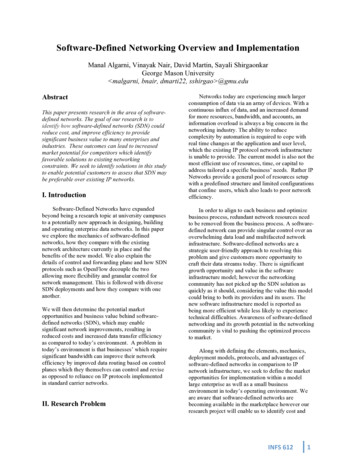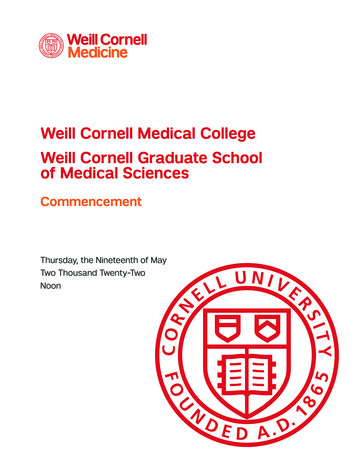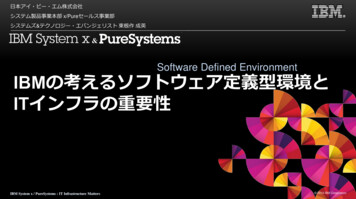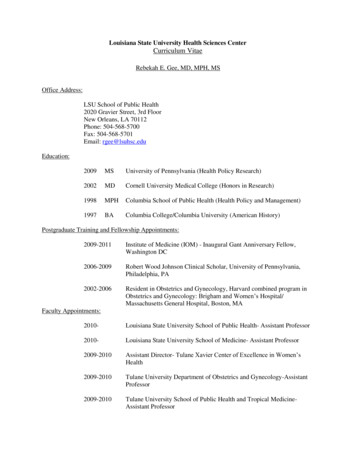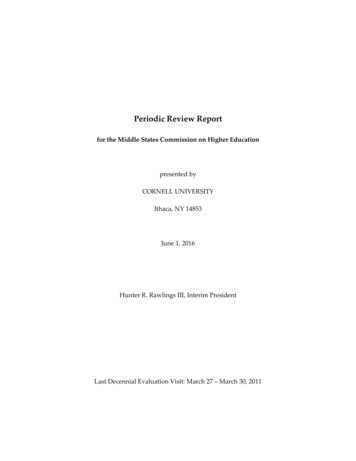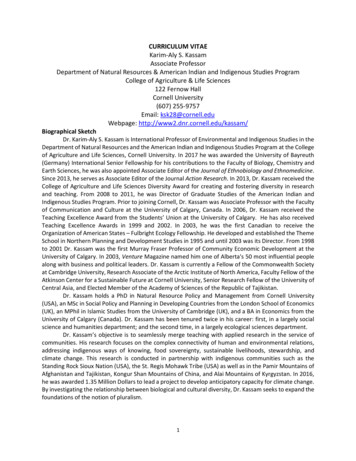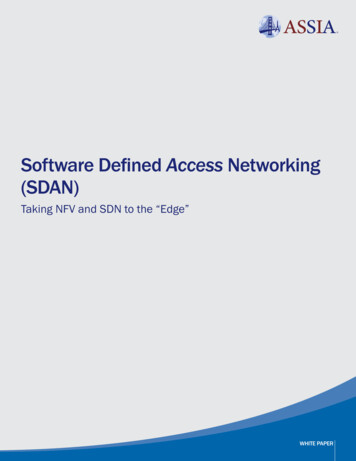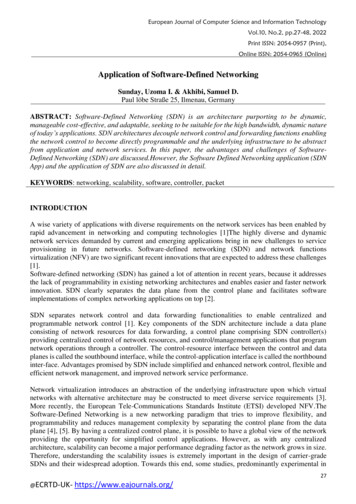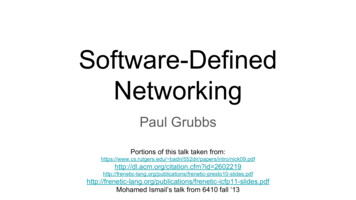
Transcription
Software-DefinedNetworkingPaul GrubbsPortions of this talk taken from:https://www.cs.rutgers.edu/ org/citation.cfm?id blications/frenetic-icfp11-slides.pdfMohamed Ismail’s talk from 6410 fall ‘13
What papers will we be discussing?OpenFlow: Enabling Innovation in Campus NetworksNick McKeown, Tom Anderson, Hari Balakrishnan, Guru Parulkar, LarryPeterson, Jennifer Rexford, Scott Shenker, Jonathan TurnerFrenetic: A High-Level Language for OpenFlow NetworksNate Foster, Rob Harrison, Matthew L. Meola, Michael J. Freedman, JenniferRexford, and David Walker.
Obligatory review ofOSI model
Network devices Layer 2 (“data link”)forwardingDifferent machines onthe same LANcommunicate via aswitchUses MAC addresses Layer 3 (“network”)routingConnects LANstogether to form aWANUses IP addressesThe joke’s on us: “switch”and “router” are usedalmost interchangeably!switchrouter
Control Plane Which packets go where?Routing (flow) tablesData Plane Get packets to the right placeUses flow table rules defined by control plane to route packets
Conventional networking Code administration hardware fused together in networkingControl plane data plane on same deviceNetworking researchers: Build new protocol Test at small scales Wait a decade for IETFstandardization DeployIndustry networking: Cisco hardwareCisco operating systemWorks best with other Ciscohardware.To change something, needsomebody certified with Ciscoto use the Cisco UI.How to scale to increase intraffic? Buy more Cisco! Hiremore CCNAs!
What is software-defined networking (SDN)? Abstracts control from routing functionalityProgrammability of the control plane Provides abstractions for device functions
History of SDN Active networking (mid 90s to early 00s) Control and data plane separation (early 00s to late 00s) Give programming interface that exposes network resources on individual devicesAbility to apply more fine-grained controls to specific packet streams“[A]nathema to many in the internet community” who valued simplicityStandardized interfaces between the two ForCES (Forwarding and Control Element Separation) IETF standardCentralize management of control plane across different devices Path Computation Element IETF standardChallenge: distributed state managementAround 2008, along comes .
OpenFlowNick McKeown, Tom Anderson, Hari Balakrishnan, Guru Parulkar, Larry Peterson,Jennifer Rexford, Scott Shenker, Jonathan Turner SIGCOMM CCR 2008Open Networking foundation manages OpenFlow protocolOpenFlow protocol supported by most major router vendors,including Cisco, IBM, Juniper, Brocade, and many others
FromMohamed’sslides
Motivation Networking researchers need to do experiments Explicitly changing routing tables in every router is very complex Small-scale experiments not accurate assessment of performance in real settingsEach vendor has their own language, hardware, etc.Why don’t we just ask the vendors to provide an open, standard platform forresearch? Vendors jealously guard internal functions of routerNo standard platform for experiments
Motivating questions “How will researchers control a portion of their local network in a way thatdoes not disrupt others who depend on it?”“[W]hat functionality is needed in network switches to enable experiments?”
FlowsWhat is a flow? packets that have the samesrc and destination (e.g. same src IP addressand port, dest IP addressand port, and protocol)What do we want to dowith a flow? Route flowIsolate flowDelete flowCompute statistics on flow“Paul’s traffic”“Traffic from Stanford”“HTTP traffic”How do we implement a flow?
Implementing a flow? Use common functionality of switch/router flow tablesOpenFlow is an open protocol to program the flow table Crucially, does not require knowledge of inner workings of deviceVendor-friendlyThree main parts: Flow tableSecure channel to controllerOpenFlow protocol (standard connection between controller and device)
The controller: it controls things Communicate with individual devices using OpenFlow Statistics queries (e.g. “How many bytes from www.google.com?”)Devices ask controller for advice on previously-unseen packets Controller can choose to install a new entry in the flow table in response to events
OpenFlow vs. IX/Arrakis? IX and Arrakis focus on making server networking fast and scalable forapplications which need very low latency (e.g. object caches) OpenFlow focuses on layer below application Modify existing kernels to move network stack to user levelPrimarily general-purpose hardwareVendor-specific hardware, little/no internal detailsDon’t modify software or hardwareInstead expose standard way to program common behaviors in different systemsIn common: abstract “control plane” from “data plane” (kind of) Both “virtualize” underlying network device
Two ways to use OpenFlowDedicated OpenFlow switchesorOpenFlow-enabled switches
Dedicated OpenFlow switches “Dumb” datapath element that implements OpenFlowThree basic actions it must perform: Forward packets in flow to port(s)Encapsulate and forward packets to controllerDeny or drop packets in flow
Dedicated OpenFlow switches
OpenFlow-enabled switches and routers Vendors implement OpenFlow API on existing devicesRequirement: Isolate research traffic from normal flows Either add a fourth action to tell device to send packet through normal flow, orDefine separate VLANs
OpenFlow-enabled switches and routers
Programming OpenFlow: NOX NOX: Towards an operating system for networks. Natasha Gude, Teemu Koponen, Justin Pettit, Ben Pfaff, Martín Casado, Nick McKeown,Scott ShenkerOpenFlow is like a device driver, NOX is like an operating system. (More on that in a bit.)
Thoughts/Questions? They didn’t really evaluate OpenFlow at all. Do you think this hurt their“pitch”?Do you believe their claim that getting vendors to cooperate is too difficult?Is putting the controller in the routing path too slow? Are there other ways todo it?What did you like or dislike about this paper?
Frenetic: A High-level Language for OpenFlow NetworksNate Foster, Rob Harrison, Matthew L. Meola, Michael J.Freedman, Jennifer Rexford, David Walker
FromMohamed’sslidesMA, PrincetonStroz Friedberg LLC
Frenetic deals with this part
Programming OpenFlow/NOX is hard. Needs low-level understanding of routers and switchesChanges to flow tables do not compose (!)Programmers need to reason about asynchronous behaviorNOX: An OpenFlow platform Platform for programming OpenFlowPaper published to SIGCOMM CCR alongside OpenFlowC API on standard Linux“NOX: Towards an Operating System for Networks”Natasha Gude, Teemu Koponen, Justin Pettit, Ben Pfaff, MartínCasado, Nick McKeown, Scott Shenker
Example NOX program?!?!?!?!?
Monitor rule is more specificthan repeater rule - must comefirst!!!!
FreNETic (get it?) Built on top of NOX/OpenFlow controllerHigh-level language using functional reactive programming paradigmImplements common features needed for flowsCompositionality is guaranteed by language and runtimeAsynchronous behavior is abstracted from programmer, handled by runtime
Core abstraction: streams
Performance compared to NOX
Thoughts/Questions? Is a custom language really easier than NOX’s approach? With Frenetic and NetKAT, the evolution of programmablenetworks looks pretty familiar Evolving pretty much how regular computers and languages did(hardware- OSs- applications) Can this give us any insight into the next few years of research in thisspace? What are the major pitfalls to avoid?What about the future of commercial programmable networks? Does it lead to fewer bugs and better programs overall?What did you like or dislike about this paper?Happy Thanksgiving!!!!
Conventional networking Code administration hardware fused together in networking Control plane data plane on same device Networking researchers: Build new protocol Test at small scales Wait a decade for IETF standardization Deploy Industry networking: Cisco hardware Cisco operating system Works best with other Cisco
